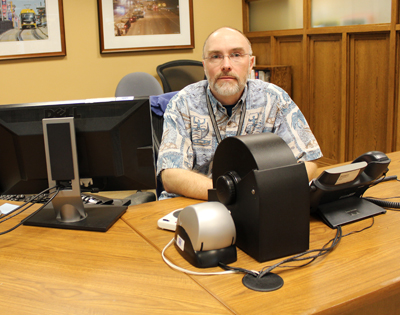|
By Shannon Fiecke, Research Services & Library

Jim Byerly works in the MnDOT library at the Central Office. Photo by Shannon Fiecke |
From his desk overlooking the State Capitol, Jim Byerly fields questions every day about Minnesota’s transportation system. How many passengers depart Minnesota airports each year? How many cars are registered in each Minnesota county? What was the past alignment of a highway? Or, as someone asked a couple years ago: What information is out there on smog-eating concrete?
“That’s pretty typical of when people come to us – what does the world know about this subject,” Byerly said.
Byerly is one of five librarians who collect, organize and manage a wide collection of current and historical reports, books and publications in the MnDOT library, which is open to the public from 8 a.m. to 4:30 p.m., on the first-floor of the Transportation Building.
“We always get questions regarding infrastructure – bridges, roads and right of way,” said Byerly, who started here in 1994. “We may not have all the answers, but we can usually find a source that does.”
A scientist by training, who has always worked for specialty libraries, Byerly enjoys the challenge of finding answers to obscure questions.
Outside of work, he likes to explore the natural world. A North St. Paul resident, Byerly is an avid hiker and downhill skier and enjoys landscape photography while traveling the country, evidenced by the collection of photographs in his cubicle.
“I never get tired of two places: Hawaii and Yellowstone National Park,” he said.
What services does the library provide and what are your responsibilities?
The library offers reference assistance, document delivery, interlibrary loan, journal routing and Wi-Fi. We also publish a monthly e-newsletter called New Library Materials, which highlights newly acquired resources. Because we have a small staff, I’m involved in all of these functions except journal routing, which is almost entirely handled by Pam Gonzalez.
Most of my time is spent providing reference and research services to customers. Responding to reference requests can run the gamut from looking up facts in printed material - yes, we still use printed resources- or online, to performing an in-depth literature search in multiple databases. Sometimes customers are looking for data, which we may reformat in a more meaningful way. I also manage the library website and electronic resources, such as online journals and databases.
What are you working on right now?
I’m working on a new set of pages for the library website. I also have a couple of reference requests that I’m researching, one on Complete Streets and one related to bituminous pavements.
What’s the oddest request you’ve received?
We were asked for information on regulations related to the transportation of a deceased individual. I was also asked the other day about the Federal Communication Commission’s use of radio waves for mind control!
What might surprise people to know about librarians?
I have a master’s degree in library and information science. That’s right, I had to get a graduate degree to do this kind of work.
What do you like most about your job?
I’m always learning something new, whether it’s about a new subject or a new way of solving a transportation-related problem. MnDOT employees are always pushing the envelope to do things better, faster and cheaper. They’re just not willing to keep doing things the same old way. That gives us the challenge of identifying and finding the information MnDOT needs to continue to do it better.
How did you become a transportation research librarian?
I studied biology in college and worked in a laboratory. After being introduced to librarianship, I decided to pursue a master’s degree in library science. After graduating, I worked in special libraries at engineering companies and a medical device manufacturer. I think that my extensive education and knowledge in the sciences gives me an increased depth of knowledge that I rely on in my work at MnDOT.
What’s been your favorite project?
Working on the many redesigns of the library website. We put up our first website in 1994. I taught myself HTML coding. It was very rudimentary, but it’s been constantly improved since that time.
Do you or a co-worker have an interesting job to share with readers? Click here to send us your ideas, and we’ll contact you for more information.
Recent employee profiles:
|



